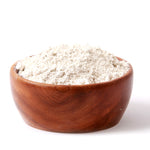- Home
- Volcanic Ash
Volcanic Ash
Couldn't load pickup availability
Volcanic Ash Powder
INCI: Pumice Powder 240 Mesh
Volcanic ash consists of very fine rock and mineral particles less than 2 mm in diameter that are ejected from a volcanic vent. Ash is created when solid rock shatters and magma separates into minute particles during explosive volcanic activity. The usually violent nature of an eruption involving steam (phreatic eruption) results in the magma and perhaps solid rock surrounding the vent, being torn into particles of clay and sand size. The plume that is often seen above an erupting volcano is composed primarily of ash and steam. The very fine particles may be carried for many miles, settling out as a dust-like layer across the landscape. This is known as an ash fall. The term for any material explosively thrown out from a vent is tephra or pyroclastic debris. If liquid magma is ejected as a spray, the particles will solidify in the air to small fragments of volcanic glass. Tephra particles of gravel size are termed cinders.
Recommended Use
A grey abrasive of volcanic origin (usually 2 to 20% in a cream or gel base).
Cautions
Unlike the ash that forms from burning wood or other combustible materials, volcanic ash is hard and abrasive, rather than soft and fluffy.
It does not dissolve in water, and it conducts electricity, especially when it is wet.
It often smells of sulfur.
Volcanic ash is not poisonous, but inhaling it may cause problems for people whose respiratory system is already compromised by disorders such as asthma or emphysema. The abrasive texture can cause irritation and scratching of the surface of the eyes. People who wear contact lenses should wear glasses if dust is present. Furthermore, the combination of volcanic ash with the moisture in the lungs may create a substance akin to liquid cement. People should also take caution to filter the air they breathe with a damp cloth or a face mask.
Specification Documents




